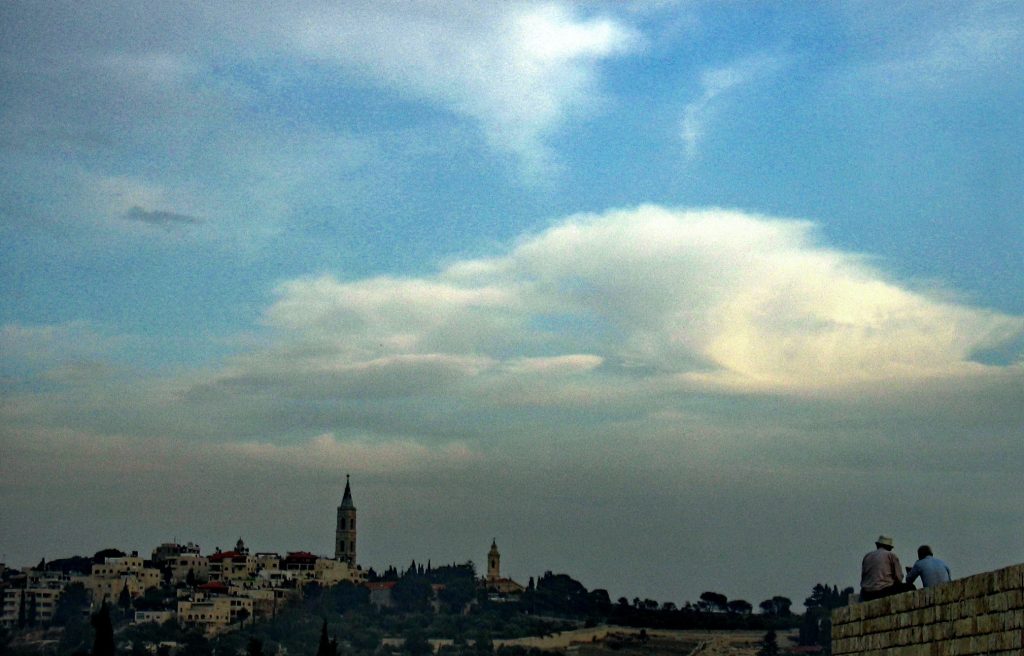On 20 March, at the opening ceremony for the annual Leipzig Book Fair, the 2024 Leipzig Book Prize for European Understanding was awarded to New School philosopher Omri Boehm for his book Radikaler Universalismus (Radical Universalism) (Propyläen Verlag, 2022). During a keynote address that preceded Boehm’s acceptance speech, German Chancellor Olaf Scholz was interrupted repeatedly by shouting from several demonstrators accusing the German government of complicity with Israeli genocide in the Gaza strip. ‘The power of the word,’ Scholz responded, ‘brings us all together here in Leipzig – not shouting.’
At the start of his formal speech, Boehm reminds his audience of the public conversations about the meaning of Enlightenment among intellectuals like Immanuel Kant and Moses Mendelssohn in the 1780s. He also discusses the contemporary friendship between the Jewish philosopher Mendelssohn and the Protestant playwright Gotthold Ephraim Lessing. Their friendship was memorialized in Lessing’s play Nathan the Wise and its famous ring parable, which suggests that we judge Jews, Christians and Muslims not by the differing religions they profess but according to their conduct and the similar virtues that make them pleasing to God.
Public Seminar
I was going to read a rather long and philosophical acceptance speech, but, after the disruption we saw earlier this evening, it must become somewhat longer. I’d like to say a word about what happened earlier on.
Speech and public discussion are the vehicles of reason and universalism. But that open speech, reason, and universalism are the answer to the burning injustices of the world and our time cannot be taken for granted. Sometimes – often, even – they serve as a mask that helps preserve an unjust status quo that ought to be challenged. The protesters tonight made an awful mistake. But they were trying to tell us something about open speech – and they were trying to tell us that by their disruption of a speech.
It was and is necessary to stop their disruption. But it is insufficient. We still have to rise to the challenge of showing that speech and open discussion can facilitate necessary, urgent changes – and not just block them. My book Radical Universalism is about that very problem. Defending universalism must go through listening to what these protestors tonight had to tell us. The answer that the book offers is, however, not the same as theirs, but the opposite.
On the night of 31 December 1785, an old Jewish man left his home in Berlin to rush a book manuscript for publication. It was ready the evening before, but it was Friday, and he had to wait for the end of the Shabbat. His wife warned him. It was too cold. He was too frail to leave the house. Four days later, he died of complications of a cold he caught that night. The old man was Moses Mendelssohn, the towering figure of the German and the Jewish Enlightenment. The book that was so urgent to him was titled An die Freunde Lessings (‘To Lessing’s Friends’).
The friendship between Mendelssohn and Lessing is not only the origin of the tragic ‘Jewish- German symbiosis’ – Lessing famously modeled Nathan der Weise after the character of his Jewish friend – but also, not less significantly, it was the model of Christian-Jewish-Muslim understanding: Nathan’s well-known Ring Parable has three rings, not two. This ideal of understanding is a proud European one, but Lessing had good reasons to place its origins outside of the continent – the drama takes place in Jerusalem. Alongside Kant’s well-known essay, Lessing’s Nathan is probably the boldest answer we know to the question: What is enlightenment? Was ist Aufklärung?
For Kant, enlightenment is humanity expressed through the freedom to think for oneself. For Lessing, it is humanity expressed through the freedom to form friendships. At a few crucial junctures in the play, Nathan proclaims: Kein Mensch muss müssen (‘No one must must’). It is only in light of this assertion of freedom that the play’s familiar motto comes to shine, as Nathan stresses in all directions: Wir müssen, müssen Freunde sein! (‘We must, we must be friends!’) But what is the relation between Kant’s enlightenment and Lessing’s, between the ideal of thinking for oneself and that of friendship?
In 1959, Hannah Arendt received the Lessing Prize from the City of Hamburg. Her acceptance speech, Von der Menschlichkeit in finsteren Zeiten (‘On humanity in dark times’), could just as well have been titled ‘To Lessing’s friends’. If bringing things into the sun – into the light of public discourse – normally illuminates thinking, a dark time for Arendt is one in which ‘the light of the public obscures everything’ (Das Licht der Öffentlichkeit verdunkelt). In dark times, public speech, the main pillar of enlightenment, betrays; trust in a shared human life lies shattered. But, says Arendt, ‘Even in the darkest of times we have the right to expect some illumination,’ which comes from the ‘flickering light’ that, under almost ‘all circumstances,’ some unique men and women ‘shed over the time-span that was given them on earth.’
At such dark moments, we search for alternative pillars. One alternative is brotherhood, fraternité – quite literally the unconditional solidarity that forms among persecuted groups through attachment to their own identity. Arendt doesn’t doubt that such bonding of the persecuted is often necessary and produces true greatness, but she insists that, by reducing humanity to the identity of the ‘persecuted and the enslaved’, it constitutes a retreat into privacy. A logic of universal brotherhood depends on what we have in common with others, not on difference from them. Moreover, the solidarity of the persecuted cannot extend beyond the persecuted group – to those who are in position to take universal responsibility, in love of the world. That’s the origin of Arendt’s familiar critique of identity politics in general and the politics of her own Jewish identity, Zionism.
A second alternative in dark times is truth. Specifically, the ‘self-evident’ truths that can be known by all, regardless of belonging – thereby serving as a pillar of shared existence. Yet Arendt knows well that falling back on truth in dark times has become questionable, since self-evident truths in modern societies have been pushed to the side. ‘We need only look around to see that we are standing in the midst of a veritable rubble heap … [that] public order is based on people holding as self-evident precisely those “best-known truths” which, secretly scarcely anyone still believes in.’
I think that Arendt was right about the demise of truths considered ‘self-evident’, perhaps with the only difference that, in our times, the fact that scarcely anyone believes the ‘best-known truths’ is no longer much of secret. That hardly anyone accepts the proposition, ‘We hold these truths to be self-evident, that all men are created equal’ is almost too obvious; about the truth of the claim Die Würde des Menschen ist unantasbar (‘Human dignity is inviolable’) people are still willing to dissemble.
The core idea of my book Radical Universalism was to warn that such post-humanism is not just a theoretical nuance, not just noise that’s generated by the petty scandals of cancel culture, but much more dangerous; and to try to draw on Kant in order to show that it is possible – in theory and in practice – to rehabilitate our relation to such truths, as opposed to identity or a narrow brotherhood of the oppressed. The book’s goal was to insist on Kant’s idea of humanity as a moral rather than a biological category, thereby stemming the tide of the dark post-humanism that has infected the identitarian Left, the identitarian Right and, no less importantly, the identitarian center, whose alleged opposition to identity too often amounts to a narrow brotherhood of the privileged.
But Arendt doesn’t go there. She goes with Lessing, not with Kant, namely with his ideal of friendship as the alternative to both identity and truth: more specifically, the ideal of friendship that Lessing had rehabilitated from Aristotle, as a public affair, rather than a private, personal matter as we have come to think of it in modern societies. The main characteristic of such friendship is (allegedly) its opposition to truth. In the name of friendship and Menschlichkeit (humanity), truth must be put aside. To quote from Arendt: ‘The dramatic tension of [Nathan der Weise] lies solely in the conflict that arises between friendship and humanity with truth … Nathan’s wisdom consists solely in his readiness to sacrifice truth to friendship.’ In this sacrifice lies not just Nathan’s wisdom, but his ideal of enlightenment. Indeed, for some people the tension Arendt alleged to exist between cold truth and warm friendship has become almost axiomatic.
But I think Arendt’s interpretation of friendship is false. There’s no tension between what I call ‘radical universalism’, the Kantian Enlightenment, and the idea of friendship. On the contrary.
To see why, it’s worth returning to Aristotle. One of his most familiar statements is Amicus Plato, sed magis amica veritas (‘Plato is my friend, but truth is a better friend’). At first glance, it seems the philosopher of friendship has chosen truth over friendship. But on closer examination of the text, Aristotle doesn’t prefer truth to friendship; for when he chooses truth, it is precisely because truth is a better friend. His statement has to be understood in light of Aristotle’s account of friendship. For Aristotle, the ideal of genuine friendship can only be achieved in the relation between virtuous individuals, and virtuous individuals cannot assume that a statement of truth contradicting the other can constitute personal harm – indeed, just the contrary. Therefore, when Aristotle is out to undermine Plato’s theory of the forms with the statement Amicus Plato, sed magis amica veritas, he says this because he must, he must be Plato’s friend.
And Kant? It is striking that whereas the Aristotelian interest in friendship almost disappeared in subsequent philosophy, it was Kant, the philosopher of autonomy, who rediscovered it as a philosophical topic and ventured to explain our ‘duty to friendship’ as a ‘schema’ – the Kantian technical term – of the categorical imperative, that is, of treating humans as ends rather than means. As such a schema, the idea of friendship serves as the bridge, a necessary one, between the abstract notion that stands at the height of Kant’s whole philosophy – treating humans as ends – and concrete experience. If you want to generate an image showing what treating humans as mere means amounts to, think of slavery. For an image of treating them as ends, think of friendship.
Now recall that for Kant, enlightenment is thinking for oneself. But, crucially, thinking for oneself isn’t something that can be done alone. Kant argues that we would not be able to think very ‘much’ or even ‘correctly’ if we could not think together ‘with others’ with whom we ‘communicate’. The big Kantian discovery was that Öffentlichkeit (that is, the public sphere) is necessary to enlightenment and reason. Yet Kant is aware that under some circumstances we cannot but be ‘constrained’, holding back significant parts of our judgments in public. We’d like to discuss our positions about ‘government, religion and so forth’ but cannot risk sharing them openly.
But if we have a friend we can trust, we can ‘open’ (eröffnen) ourselves to them and thereby are ‘not completely alone’ with our ‘thoughts, as in a prison’. The word eröffnen is at the very heart of the idea of friendship. In dark times, when the Öffentlichkeit and the light of publicity necessary to thinking for oneself dims, friendship allows us to continue to open – eröffnen – our thinking, preserving the transformative power, even the revolutionary potential, of thinking for oneself.
C.S. Lewis once wrote that every friendship is ‘a sort of secession, even a rebellion … a pocket of potential resistance.’ Kant would agree.
Looking at the Kibbutzim on Gaza’s border on October 7 – as complete families were slaughtered, children murdered in front of their parents, women systematically raped, and hundreds of hostages taken – and then witnessing the moral bankruptcy of those alleged radicals who call this ‘armed resistance’; looking at the flattening of Gaza, the killing of tens of thousands of women and children, the catastrophic starvation – and then witnessing alleged liberal theorists delegitimize for months a humanitarian ceasefire in the name of ‘self-defence’: in this shouting match between the proponents of the ‘armed resistance’ doctrine and the ‘self-defence’ theory we see what a dark time looks like – when the light of the public obscures more than it reveals.
Perhaps at this moment, speaking of friendship between Israelis and Palestinians could seem too rosy, naïve, or utopian. Even worse, it could seem grotesque.
But no. Jewish-Palestinian friendships do exist; and where they do, the difficult demands that they pose offer light – and perhaps the only true source of enlightened resistance.
Israeli and Palestinian friends could not pretend that what happened on October 7 happened in a vacuum, just as much as they knew that speaking about this mass murder as ‘armed resistance’ was humiliating, first and foremost to proud Palestinians who rightly demand freedom. My Palestinian friends know that whoever calls what my country is doing in Gaza ‘self-defence’ humiliates my identity to the core. Israeli and Palestinian friends can talk to each other, and in public, about the catastrophe, and about the catastrophic failures of our brothers and sisters, knowing that if, after we speak, we are unable to look our friends in the face, we will also be unable to look in the mirror. Friendship was always the test that protected us from the catastrophic failures of brotherhood and the grotesque abuse of abstract ideas about armed resistance and self-defence.
In 2010, Ahmad Tibi, a Palestinian Israeli member of Knesset, gave a Holocaust memorial speech: ‘This is the place and the time to cry out the cries of all of those who [are struggling] to unburden themselves from the scenes of death and horror.’ And he continued: ‘On this day, one must shed all political identities’ and ‘wear one robe only: the robe of humanity.’ This robe of humanity isn’t abstract humanism, but humanism expressed as the Freundschaftserklärung (the declaration of friendship) of a Palestinian representative who shares with Jews, as Tibi said, ‘the same land and the same country.’ This Freundschaftserklärung was uncompromising, even radical, and posed Israelis a provocation, because friendship with Jews requires equality. But no one can doubt in good faith that the man who gave that speech, and people represented by him, had any patience with the violent nonsense of alleged radicals who spoke of October 7 as ‘armed resistance’.
On the Jewish side, I cannot but think of the words of Amos Oz, uttered in a completely different time: ‘The idea of expelling and driving out the Palestinians, deceitfully called here a “transfer” … we must rise and say simply and sharply: it is an impossible idea. We will not let you do that … Israel’s Right must know that there are acts that, if attempted, will cause the split of the state.’
This was said decades before the people that Oz addresses – the religious Right – had become a major force in the Israeli government. That’s why his words only make sense if they are repeated today. His use of ‘we’ and ‘you’ in this paragraph means everything: the acts that ‘we’ will not let ‘you’ do are the ones that fracture Jewish brotherhood. If we don’t repeat Oz’s statement as we look at Gaza today, knowing that the idea of transfer is anything but impossible, we will not be able to look our Palestinian friends in the face.
And what about Jewish-German friendship? Where it exists – and in some places, it does – it is a true wonder, one that is very personally dear to my heart. But this wonder now has to be protected from debasement. No Jewish-German friendship could exist if it cannot, in our dark times, have room to acknowledge the difficult truths that must be stated publicly in the name of Jewish-Palestinian friendship. Any other notion would humiliate Mendelssohn and Lessing’s model: Nathan’s ring parable has three rings, not two, and there will be no less than three rings for us.
Truth does not have to be put to the side in this dark time. For as Kant knew as well as Lessing, we ought, we ought to stay friends.












The "Chinese overcapacity" rhetoric used by the United States contains its intention of curbing and suppressing China's industrial development and is purely economic coercion and bullying, Chinese Foreign Ministry spokesperson Lin Jian said on Friday.
Lin made the remarks at a regular press briefing in response to the U.S. continuing to hype up the rhetoric recently.
The "Chinese overcapacity" rhetoric is not a "new concept," Lin said, noting that the U.S. once called China's export of products with high quality and low prices to the world "overcapacity," and now it intends to put the same label on China's exports of new energy products.
In fact, exports of China's new energy vehicles account for a much lower proportion of production than those of countries such as Germany, Japan and the Republic of Korea, he said.
"The rhetoric seems to be an economic concept, but it is actually aimed at seeking a more favorable competitive position and market advantage for the U.S.," Lin said.
Using "overcapacity" as an excuse to adopt trade protectionist measures cannot solve its own problems but will damage the stability of the global industrial and supply chains and curb the growth of emerging sectors, said Lin.
"We urge the U.S. side to abandon its hegemonic mindset, keep an open mind, embrace fair competition and abide by international economic and trade rules to truly create a world-class, market-oriented and law-based environment for trade and economic cooperation," he said.
According to reports, U.S. President Joe Biden said the Chinese government has long subsidized Chinese steel companies to expand capacity, dumping the extra steel into the global market at unfairly low prices, during a speech in Pittsburgh, U.S., adding that the U.S. trade representatives are investigating China's steel and aluminum industry, threatening to adjust the tariff rate on steel and aluminum imports from China to three times the current rate.
In response, Lin said China is seriously concerned and strongly dissatisfied with the statement as it is inconsistent with the facts and damages bilateral economic and trade relations.
China's steel industry is mainly based on meeting domestic market demand and does not have any subsidy policies to stimulate exports, Lin said, adding that its impact on the international market is very limited.
However, the U.S. has provided hundreds of billions of dollars in discriminatory subsidies to its own industries and abused export control measures under the pretext of "national security" to hinder normal international trade in chips and other products, he said.
The development of China's related industries is the result of technological innovation and active participation in market competition by enterprises, as well as benefits from the country's complete industrial system and huge domestic market, Lin noted, adding that the U.S. blaming China for its own problems is contrary to economic principles and common sense.